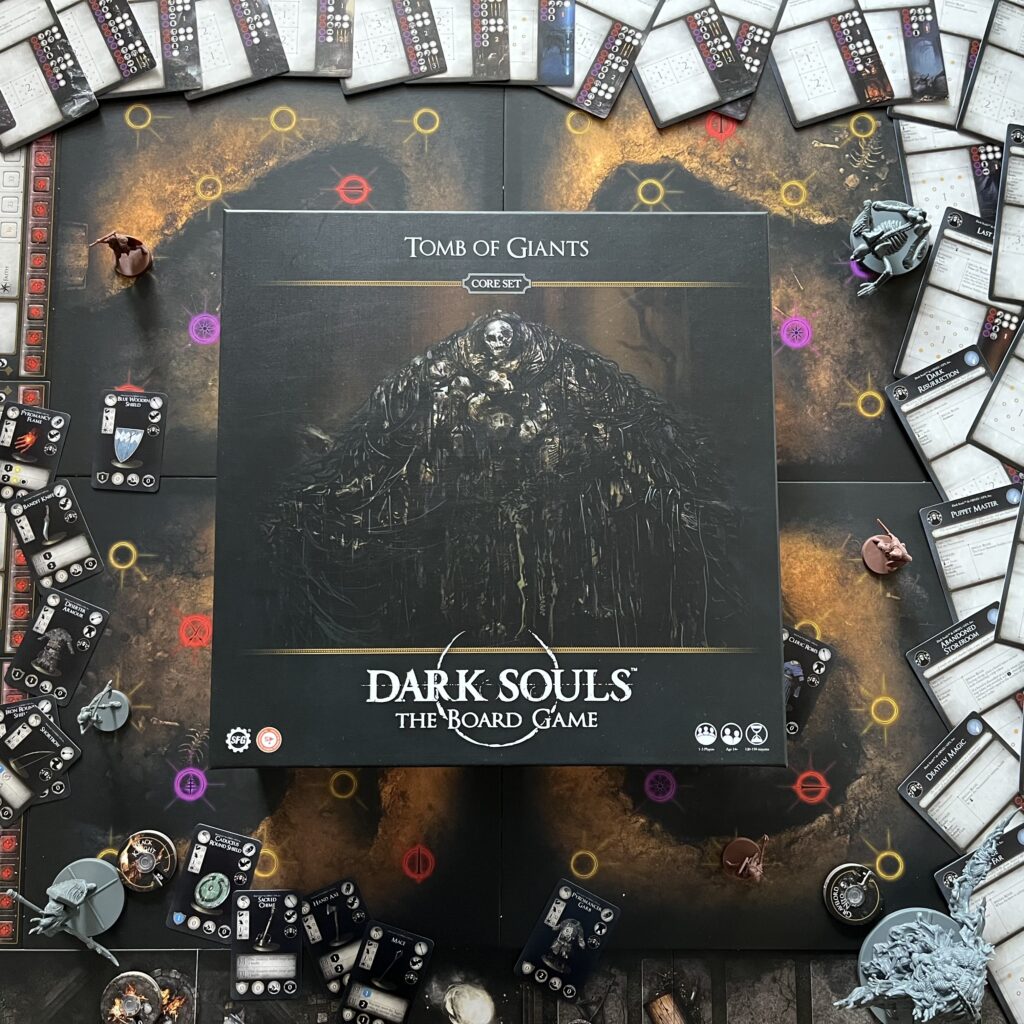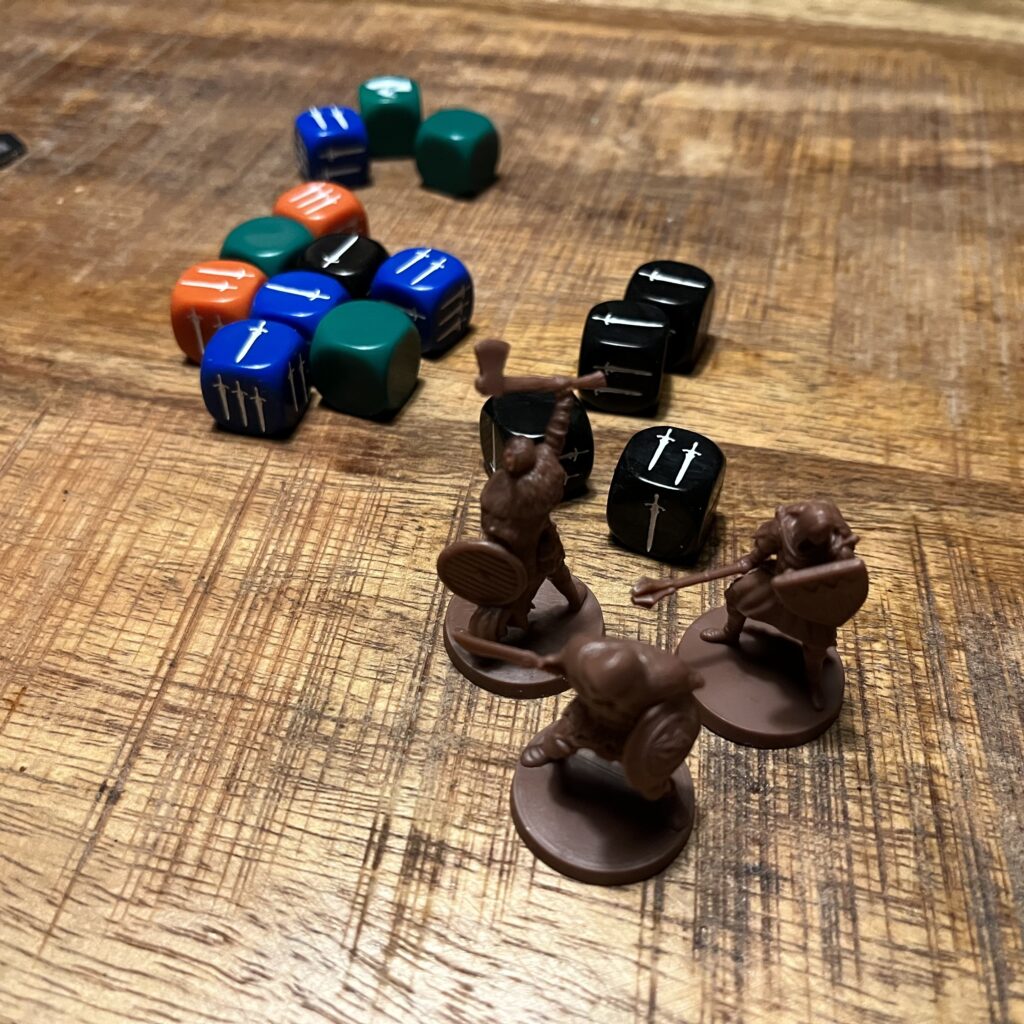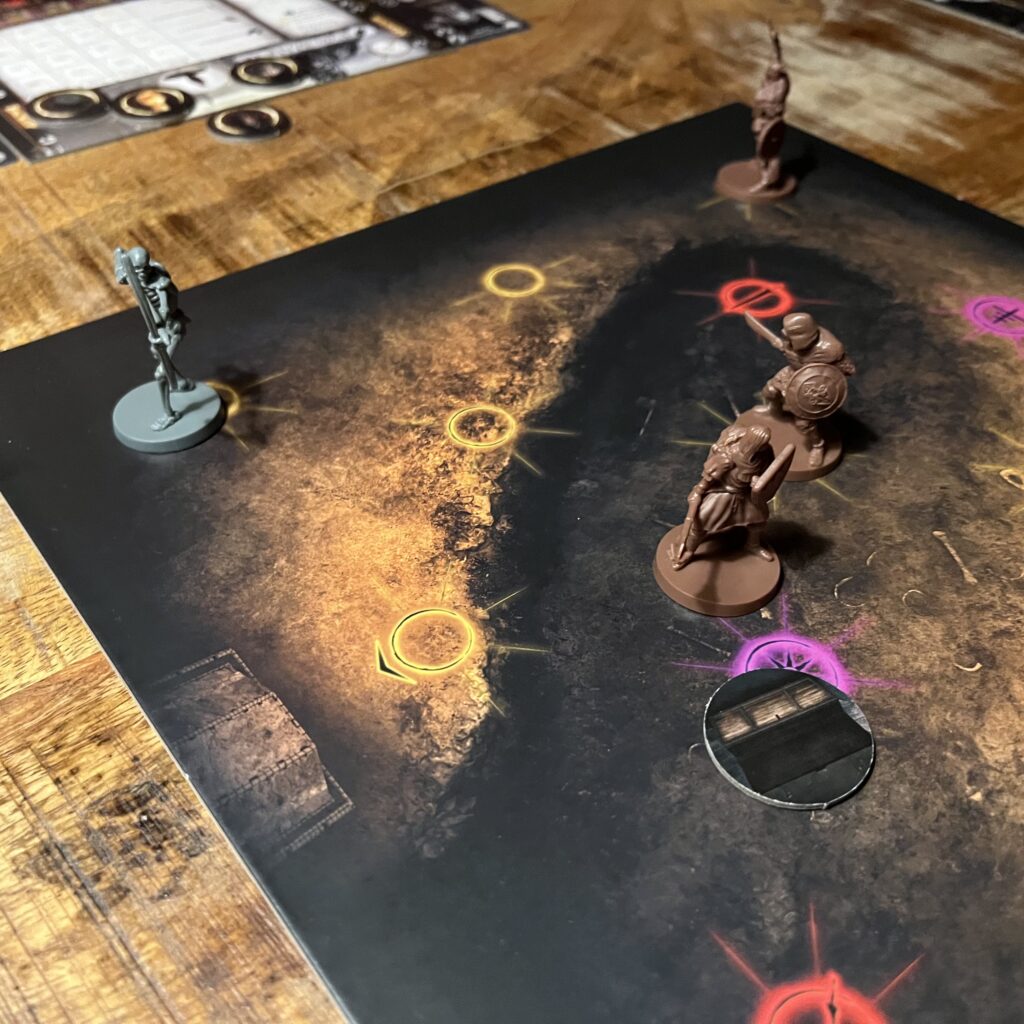Gravelord Nito was one of the Lords who waged war against the dragons and is also a holder of one of the Lord Souls. As Lord of Death, Nito rules over the (un)dead in the Tomb of Giants located under the Catacombs. Nito’s army of giant skeletons and undead guard his tomb. Do you (possibly with the help of others) know how to defeat Gravelord Nito and claim his Lord Soul?

Background
Dark Souls Tomb of Giants is a dungeon crawler board game published by Steamforged Games, well known for their games and RPG supplements consisting of many detailed miniatures. Dark Souls Tomb of Giants is a (partial) reprint and supplement to Dark Souls The Board Game, also from Steamforged Games, which was released a few years ago after a large Kickstarter campaign. Steamorged has since released several standalone sets that complement or replace and streamline the original game.
Like the Horizon Zero Dawn board game and Resident Evil board games published by Steamforged, this Dark Souls board game set is also based on a video game series of the same name from Japanese publisher FromSoftware. FromSofware has been creating and developing different types of games since the 1980s, including the popular mecha series of games: Armored Core. FromSoftware became immensely popular in the West thanks to its so-called “Soulslike” games. In 2009, this publisher released Demon’s Souls for the PlayStation and pretty soon this game gained a large cult following, thanks to its difficulty, many secrets and dark atmosphere and storyline. In 2011, FromSoftware released a spiritual sequel to Demon’s Souls: Dark Souls. Dark Souls appeared on multiple platforms and was hugely successful and popular. It was so successful that a total of three Dark Souls games were released, a remake of the first and its continued success led to the creation of a subgenre of action role-playing games that are indeed better known as so-called Soulslikes. Besides Demon’s Souls, Dark Souls and the remakes of these titles, From Software also released Bloodborne in 2015 (inspired by horror literature from Victorian times full of vampires and werewolves combined with the Cthulhu mythos), Sekiro: Shadows Die Twice in 2019 (inspired by Japanese folklore and mythology) and the open-world Soulslike game Elden Ring in 2022. All these games are popular among the video gaming public and were also well received by critics. Board games based on those video games were a given and besides Dark Souls, a BloodBorne board game was also released and an Elden Ring board game has been announced (the latter is also being developed and published by Steamforged).
An important part of all of these mentioned video games are players’ clashes with powerful enemies and monsters, discovering environments based on limited information, discovering and unlocking new equipment and collecting Souls (or similar spiritual currency). Death is the not the end in these games, but often just the beginning. Every time a player dies or voluntarily visits a resting place (in Dark Souls, a bonfire) it gives an opportunity to use amassed Souls to get better and buy new equipment. One drawback is that regular enemies you had already defeated return to the game world. Players have to partially restart from certain spots, just until they discover short routes or unlock new bonfire locations.
Dark Souls Tomb of Giants is inspired by a specific location in the first Dark Souls video game: quite obviously the Tomb of Giants. This tomb is filled with skeletons, many of which are gigantic, as you would expect based on the name of this peculiar and scary location. At the end of the tomb, Gravelord Nito awaits. He is a kind of ‘rat king’ (look up this phenomenon) consisting of various skeletons, bones and other abominations. The Dark Souls board game series tries to incorporate the various elements of the video games into a board game and, as a result, many parts will not be unfamiliar to fans of the video games.
Setup
The Dark Souls Tomb of Giants game contains many miniatures and other game components, but fortunately the most important components are a number of encounter cards, and for now you can set many of the components aside as you will need them for specific encounters. At the start of the game, each player chooses a character and grabs the corresponding parts and cards (equipment). On the table, players place the long board with the corresponding stacks of cards (encounters, treasures and events) and place a bonfire disc to keep track of how many visits players can still make to the bonfire (if players can’t make any more visits then they are game over), a token to keep track of where players are in the tomb and all other items are placed in reach until they are needed. Players are ready to play.


Gameplay
Dark Souls Tomb of Giants is a cooperative dungeon crawler in which players explore the tomb until they die (for the last time) or until they manage to defeat Gravelord Nito. Despite what the lengthy manual suggests, the gameplay of Dark Souls Tomb of Giants is fairly easy to understand. There are minor details that players need to take into account, but basically the gameplay is as follows. Depending on the location of players in the tomb (indicated on the central game board), two encounter cards are drawn from a specific deck. On the encounter cards, players see specific elements and rules of their encounter such as the game boards to be placed on the table, which and how many enemies to face and how to win an encounter. Players choose one of these and place the chosen card under the central game board. Pursuant to the encounter card’s instructions, they set up the encounter and are ready for a crawl and brawl.
A round usually consists of several turns where (usually) the enemies take a turn first, then one of the players, then the enemies again, and so on. There are different types of enemies and each enemy has an action card with specific rules, attacks and moves of this enemy. Boss battles proceed slightly differently and boss monsters have a deck of cards, but the principle is largely the same. Players follow the given instructions for all enemies (letting skeletons run and attack if possible according to the rules) and then it’s a player’s turn.
During their turn, a player can move, use stamina to move more and perform an action. In principle, players only have attacks or equipment actions, but depending on the encounter, players may have other actions at their disposal, such as pulling a lever or opening a treasure chest. Equipment cards indicate how an attack/action should be performed (e.g. the distance, or how much stamina an action does). When attacking or being attacked, players must roll the corresponding dice to see whether their attack is successful and how much damage is done or in the case of defending whether they have evaded or blocked the attack. Attack power is reduced by defence power, but keep in mind the difference between physical and magical attacks.
If a player dies during an encounter, all players must return to the bonfire. If players have passed an encounter they move on to the next encounter or can return to the bonfire. If players return, they must lower the bonfire value. If they cannot lower it, they have lost the game. Each time players return they have to start at the beginning of the tomb again, unless they have discovered a shortcut, in which case they may start at a later encounter.
Verdict
Like other Steamforged Products, the miniatures are wonderfully detailed. Overall, and production quality is puking, but the player boards, on which players keep track of their level, stamina and damage, is a bit questionable. Indeed, players have to keep track of these stats with pieces of cardboard printed out of the player boards themselves. This causes some fiddling and possibly frustration. It would have been easier to use simple wooden blocks. In addition, the rules and some parts of the game feel less finished due to some production flaws. For instance, certain tokens are not printed double-sided when they were actually meant to be and some cards, items and rules have wrong information or other mistakes included on them.


Dark Souls, like the video game, is unrelenting, in that players only get a limited number of chances and have to virtually start over if they are defeated or volunteer to visit a bonfire. As a result, this dungeon crawler is also actually too long to play during a single sitting. The game’s creators recommend playing a game over several sessions, but there is no way to easily ‘save’ the game without the need to write down information or take pictures. Perhaps you could bag the different parts? Due to the potentially very long game duration, the game can feel touching at some point, so we do recommend pausing.
The gameplay itself is simple and challenging enough, and during encounters you will face interesting dilemmas. Stamina and life force are tracked on the same track which also means it’s the end of the game if you’ve used a lot of stamina which means you can take less damage. Many interesting actions use stamina, often leaving you faced with a difficult choice: do I sacrifice stamina and then risk more? Like Horizon Zero Dawn, Dark Souls Tomb of Giants faithfully implements the video game as well as its atmosphere.




